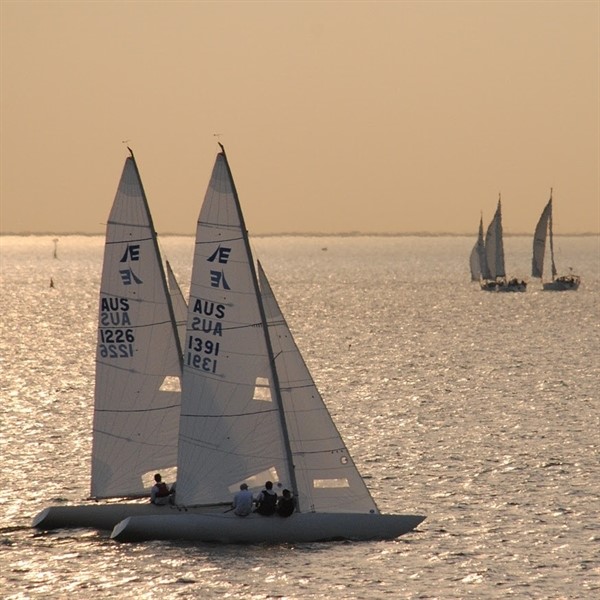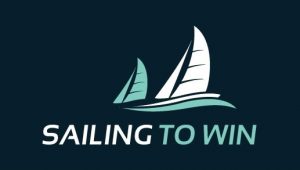

We all need upwind sailing tips and who better to tell us how other than Noel Drennan
Noel is well known across the world in sailing circles and has done and achieved more than most sailors could ever dream of in their lifetime and therefore is imminently qualified to give us tips about how to get faster upwind.
Classes he has sailed include the Laser, Etchells, Farr 40, RC 44, TP 52, A class cat, Maxis, Ocean racers, and Soling plus he has sailed many other types of boats from Arabian Dow to the Version 5 Americas Cup boats.
Noel has been part of four Americas cup campaigns. In 2000 and 2003 he sailed on Stars and Stripes with Dennis Conner plus competed in the Volvo round the world Ocean Race in 2001 and 2005 winning in 2001 with “Illbruck” and completed the circumnavigation on “Movistar” in 2005.
Noel has sailed in 33 Sydney to Hobart races winning overall twice and has sailed on boats that have won line honours three times.
How do you recognize whether a shift is velocity-driven or an actual shift?
Essentially, most shifts will usually happen with a velocity drop or a velocity increase, but essentially, before the start of the race, I try and get my head to wind reading and check the wind. I’ll try to do it in the lulls or in a gust and see if there’s a pattern there, and go from there.
What’s the most important trim adjustment when you’re going upwind?
I think just as simple as the main sheet, it does so much in all boats, from dinghies to keelboats. And the main sheet is the absolute key adjustment for the balance and trim.
Speaking of trim, can you actually feel it when you’re sitting on the side of the boat.
For me, that’s been a very important factor for my success in that I have the dinghy feel, but I’ve sailed a lot on keelboats, so you’re feeling what’s happening with the boat.
It’s loading up or unloading, or the mainsheet’s too tight for acceleration, whatever it is, but on a keelboat, you’ll also have an instruments package that will quantify that.
If you have the feel from previous dinghy sailing, then you’ll be ahead of the instruments and that’s what you need to be.
As you approach the weather mark and you get lifted ten degrees above the mark, how would you handle this?
I would probably sail above the mark for sure, to take the shift and get above and just for the clean lane around the mark yes, probably somebody will gain by going to the mark, putting the bow down and going at the mark.
You hear it often said that you should always sail towards the next shift is there a reason why you should sail towards the next shift?
Not really, but it usually does work out as an advantage. It really depends if you know it’s more likely to be a header on one side of the course or not.
I don’t think it’s always a golden rule that you should sail towards the next shift. It might be a lift and you might end up being to leeward of everybody.
How do clouds influence your upwind strategy?
I’ll always look up and look at the clouds. If I was sailing in Melbourne, for sure on the day I’d be looking for the sea breeze clouds building on the land or if it’s any sort of southerly or westerly, just the cloud formations which give you a hint of what is coming.
Because I’ve done a reasonable amount of ocean racing, and in the Volvo ocean race you sail with really good navigators, when they come up on deck they just tell you to look at the cloud, and go to the right-hand side of it and you’ll be lifted, or stay away from that one.
You learn what to stay away from or when safe to go towards. Which side of the clouds you’re going to be lifted and which side you’re going to be headed. I think it’s a pretty important thing to do.
It’s often said that you must sail the long the tack first when heading to a mark, why is that?
I think it’s a pretty good rule, essentially because you don’t really know what’s going to happen next, and if you’re getting close to the top mark you don’t want to end up on one layline, you just want to have options.
Should you sail for puffs or shifts?
Essentially it’s a little bit to do with the boat. If it’s a boat like in an Etchells…if you’re racing to six to eight knots, it’s wind speed. And over probably 10, it’s probably the shift.
Downwind in a planing boat, I go for windspeed every time.
When you’re going upwind, what sort of feedback are you looking for from your crew?
I like to actually have a pretty well-defined person who is looking around. They are the member of my crew who gives me a good description of how we’re actually going.
As the forward hand, you’ve got the best option to look around. It depends on the crew, we might have someone that is better but is on the main sheet.
This might be a bit class-specific, but how much and when do you play the jib sheet on the beat?
I think it’s pretty important. And it’s more where you are on the racecourse, and deciding what your next move tactically will be. If you get a lift, if I want to get to the right side, ease and play the jib. Boats like the Etchells will accelerate better with the jib eased, you can almost leave the main.
Mainsail twist, what do you look for in different wind conditions and wave conditions?
I’d use the leech ribbons as a bit of a guide in certain conditions to make sure I’m not over-trimmed.
Look at the leech and the telltales in the middle of the sail. See, if they’re lifting or they’re stuck or flowing. Consider the backwind from the jib on the luff of the main.
If the mainsail back wind is starting down low, the jib cars are down too low or in too far.
In Melbourne where we sail a lot, you get extreme conditions from flat water, bumpy water and tack to tack. It’s so different starboard and port, so in most cases, you have to acquire a different setup on each tack.
If I knew that we are going into the waves on port tack, we’ll set up for more twist, and I’ll ease the backstay, and I might make one or two other minor adjustments because if I know I have to have more twist because of the waves, I’ll set this up to be slightly deeper.
I’m assuming it’s all about balance?
It’s such a difference between a big boat and a small boat with the board, but absolutely. Quite often in dinghies, the board is just put down and not adjusted. The position and depth of the board is a factor in the whole balance of the boat.


